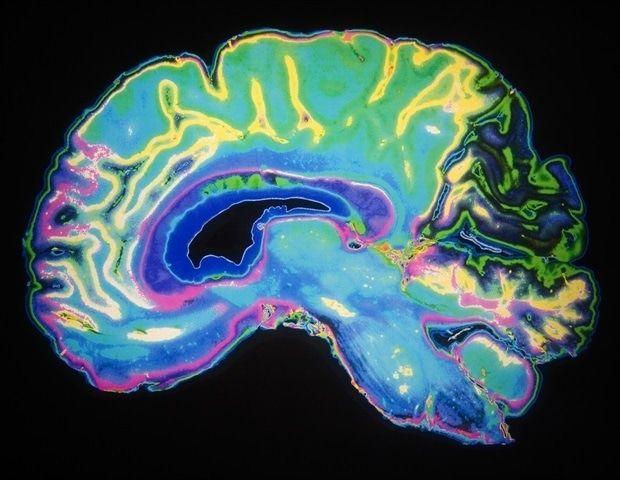Graphene Technology Accelerates Brain Organoid Maturation, Opening New Avenues for Neuroscience and AI
2 Sources
2 Sources
[1]
Graphene technology matures brain organoids faster, may unlock neurodegenerative insights
Researchers from the University of California San Diego Sanford Stem Cell Institute have developed a novel method to stimulate and mature human brain organoids using graphene, a one-atom-thick sheet of carbon. Published in Nature Communications, the study introduces Graphene-Mediated Optical Stimulation (GraMOS), a safe, non-genetic, biocompatible, non-damaging way to influence neural activity over days to weeks. The approach accelerates brain organoid development -- especially important for modeling age-related conditions like Alzheimer's disease -- and even allows them to control robotic devices in real time. "This is a game-changer for brain research," said Alysson Muotri, Ph.D., corresponding author, professor of pediatrics, and director of the UC San Diego Sanford Stem Cell Institute Integrated Space Stem Cell Orbital Research Center. "We can now speed up brain organoid maturation without altering their genetic code, opening doors for disease research, brain-machine interfaces and other systems combining living brain cells with technology." A smarter way to grow the brain in a dish Brain organoids -- three-dimensional, stem cell-derived models of the human brain -- are valuable for studying neurological diseases, but they usually mature slowly, limiting their usefulness for conditions that develop over decades. Until now, stimulation methods either required genetic modification (optogenetics) or direct electrical currents, which can damage fragile neurons. GraMOS works by using graphene's unique optoelectronic properties to convert light into gentle electrical cues that encourage neurons to connect and communicate. This stimulation mimics the environmental input real brains receive, driving development without invasive techniques. "Using graphene and light, we were able to nudge the neurons to form connections and mature more rapidly, without traditional optogenetic tools," said Elena Molokanova, Ph.D., co-corresponding author and chief executive officer and inventor of GraMOS technology at NeurANO Bioscience. "It's like giving them a gentle push to grow up faster -- essential for studying age-related diseases in a dish." Key study findings include: * Faster development: Regular use of GraMOS helped brain organoids form stronger connections, better organized networks, and more advanced communication between neurons -- even in models made from Alzheimer's patients. * Safe and biocompatible: Graphene did not harm neurons or organoid structure, even over long periods. * Enhanced disease modeling: Early-stage Alzheimer's organoids revealed functional differences in network connectivity and excitability when stimulated. * Robotic integration: Graphene-stimulated organoids were linked to a simple robot in a closed feedback loop, enabling it to respond to visual cues. From the lab to Alzheimer's research and beyond Because stimulation accelerates neural maturation, researchers can study disease progression sooner and in a more physiologically relevant context. This could improve drug testing timelines and provide new insight into how diseases like Alzheimer's alter brain circuitry. "Our technology bridges a critical gap in organoid research," said Alex Savchenko, Ph.D., co-senior author and chief executive officer of Nanotools Bioscience. "It offers a reliable, repeatable way to activate neurons, which can transform both fundamental neuroscience and translational studies." Brain meets machine Brain organoids interfaced with graphene become responsive to their environment and can change their neuronal networks in response to light. This acquired neuroplasticity offers a huge advantage over computer chips in future artificial intelligence (AI) applications by improving the ability of AI systems to solve complex, unforeseen problems and offering greater fault tolerance and reliability in critical applications. In a striking proof-of-concept, the team connected graphene-interfaced brain organoids to a robotic system equipped with sensors. When the robot detected an obstacle, it sent a signal to stimulate the organoid, which then generated a neural pattern triggering the robot to change course -- completing the loop in under 50 milliseconds. While still far from conscious machines, this integration hints at future neuro-biohybrid systems where living neural tissue and robotics work together for advanced prosthetics, adaptive interfaces or even new forms of computation. This study is a major step toward unlocking the potential of graphene in neuroscience, nanotechnology and neuroengineering. The technology could lead to new ways of connecting increasingly complex brain-like tissues to each other -- and even to the brain itself. The ability to control and accelerate brain organoid development opens the door to using them as powerful models for testing therapies for neurodegenerative and developmental brain disorders, where damaged connections can disrupt the brain's ability to process and respond to information. Beyond disease research, the approach could be adapted for tissue engineering, offering a noninvasive, precise way to stimulate other types of lab-grown tissues. And by linking living neural networks to machines, researchers may discover how the brain's adaptability and learning could enhance computers and robotics -- with possible future applications in artificial intelligence. "This is only the beginning," said Muotri. "The combination of graphene's versatility and brain organoid biology could redefine what's possible in neuroscience, from understanding the brain to creating entirely new technological paradigms."
[2]
New Graphene Technology Matures Brain Organoids Faster, May Unlock Neurodegenerative Insights | Newswise
Newswise -- Researchers from University of California San Diego Sanford Stem Cell Institute have developed a novel method to stimulate and mature human brain organoids using graphene, a one-atom-thick sheet of carbon. Published in Nature Communications, the study introduces Graphene-Mediated Optical Stimulation (GraMOS), a safe, non-genetic, biocompatible, non-damaging way to influence neural activity over days to weeks. The approach accelerates brain organoid development -- especially important for modeling age-related conditions like Alzheimer's disease -- and even allows them to control robotic devices in real time. "This is a game-changer for brain research," said Alysson Muotri, Ph.D., corresponding author, professor of pediatrics, and director of the UC San Diego Sanford Stem Cell Institute Integrated Space Stem Cell Orbital Research Center. "We can now speed up brain organoid maturation without altering their genetic code, opening doors for disease research, brain-machine interfaces and other systems combining living brain cells with technology." Brain organoids -- three-dimensional, stem cell-derived models of the human brain -- are valuable for studying neurological diseases, but they usually mature slowly, limiting their usefulness for conditions that develop over decades. Until now, stimulation methods either required genetic modification (optogenetics) or direct electrical currents, which can damage fragile neurons. GraMOS works by using graphene's unique optoelectronic properties to convert light into gentle electrical cues that encourage neurons to connect and communicate. This stimulation mimics the environmental input real brains receive, driving development without invasive techniques. "Using graphene and light, we were able to nudge the neurons to form connections and mature more rapidly, without traditional optogenetic tools," said Elena Molokanova, Ph.D., co-corresponding author and chief executive officer and inventor of GraMOS technology at NeurANO Bioscience. "It's like giving them a gentle push to grow up faster -- essential for studying age-related diseases in a dish." Because stimulation accelerates neural maturation, researchers can study disease progression sooner and in a more physiologically relevant context. This could improve drug testing timelines and provide new insight into how diseases like Alzheimer's alter brain circuitry. "Our technology bridges a critical gap in organoid research," said Alex Savchenko, Ph.D., co-senior author and chief executive officer of Nanotools Bioscience. "It offers a reliable, repeatable way to activate neurons, which can transform both fundamental neuroscience and translational studies." Brain meets machine Brain organoids interfaced with graphene become responsive to their environment and can change their neuronal networks in response to light. This acquired neuroplasticity offers a huge advantage over computer chips in future artificial intelligence (AI) applications by improving the ability of AI systems to solve complex, unforeseen problems and offering greater fault tolerance and reliability in critical applications. In a striking proof-of-concept, the team connected graphene-interfaced brain organoids to a robotic system equipped with sensors. When the robot detected an obstacle, it sent a signal to stimulate the organoid, which then generated a neural pattern triggering the robot to change course -- completing the loop in under 50 milliseconds. While still far from conscious machines, this integration hints at future neuro-biohybrid systems where living neural tissue and robotics work together for advanced prosthetics, adaptive interfaces or even new forms of computation. This study is a major step toward unlocking the potential of graphene in neuroscience, nanotechnology and neuroengineering. The technology could lead to new ways of connecting increasingly complex brain-like tissues to each other -- and even to the brain itself. The ability to control and accelerate brain organoid development opens the door to using them as powerful models for testing therapies for neurodegenerative and developmental brain disorders, where damaged connections can disrupt the brain's ability to process and respond to information. Beyond disease research, the approach could be adapted for tissue engineering, offering a noninvasive, precise way to stimulate other types of lab-grown tissues. And by linking living neural networks to machines, researchers may discover how the brain's adaptability and learning could enhance computers and robotics -- with possible future applications in artificial intelligence. "This is only the beginning," said Muotri. "The combination of graphene's versatility and brain organoid biology could redefine what's possible in neuroscience, from understanding the brain to creating entirely new technological paradigms." Link to full study. Additional co-authors on the study include: Mariana S.A. Ferraz, Angels Almenar-Queralt, Georgia Chaldaiopoulou, Janaina Sena de Souza, Francesca Puppo and Pinar Mesci from UC San Diego School of Medicine; Teng Zhou, Michael Reiss, Honieh Hemati, Francisco Downey and Omowuyi O. Olajide from UC San Diego School of Engineering; Pragna Vasupal from NeurANO Bioscience; Volodymyr P. Cherkas from Institute of Bioorganic Chemistry at the Polish Academy of Sciences and the Bogomoletz Institute of Physiology; Prashant Narute and Dmitry Kireev from University of Massachusetts, Amherst; Carolina Thörn Perez from Universidade Federal do ABC; and, Samuel L. Pfaff from the Salk Institute for Biological Studies. The study was funded, in part, by the National Institutes of Health (A.S.: 1R43MH124563; A.R.M: 1R01MH128365, R01NS123642, 1R01ES033636, MH123828, MH127077, NS105969; EM: 1R43NS122666, 1R43AG076088, 5R44DA050393), Department of Defense W81XWH2110306 (to A.R.M.), the California Institute of Regenerative Medicine (DISC2-13866 to A.S.), and the Long-term program of support of the Ukrainian research teams at the Polish Academy of Sciences carried out in collaboration with the U.S. National Academy of Sciences with the financial support of external partners to V.C.
Share
Share
Copy Link
Researchers at UC San Diego have developed a novel method using graphene to stimulate and mature human brain organoids faster, potentially revolutionizing neurodegenerative disease research and brain-machine interfaces.
Breakthrough in Brain Organoid Research
Researchers from the University of California San Diego Sanford Stem Cell Institute have made a significant advancement in brain organoid technology. They have developed a novel method called Graphene-Mediated Optical Stimulation (GraMOS) to stimulate and mature human brain organoids using graphene, a one-atom-thick sheet of carbon
1
2
.The GraMOS Technology

Source: Medical Xpress
GraMOS is a safe, non-genetic, biocompatible, and non-damaging way to influence neural activity over extended periods. It works by utilizing graphene's unique optoelectronic properties to convert light into gentle electrical cues, encouraging neurons to connect and communicate. This stimulation mimics the environmental input real brains receive, driving development without invasive techniques
1
2
.Accelerated Maturation and Enhanced Research Potential
The new approach significantly accelerates brain organoid development, which is particularly crucial for modeling age-related conditions like Alzheimer's disease. By speeding up neural maturation, researchers can study disease progression sooner and in a more physiologically relevant context. This could potentially improve drug testing timelines and provide new insights into how neurodegenerative diseases alter brain circuitry
1
2
.Key Findings and Advantages
- Faster development: Regular use of GraMOS helped brain organoids form stronger connections, better organized networks, and more advanced communication between neurons.
- Safety and biocompatibility: Graphene did not harm neurons or organoid structure, even over long periods.
- Enhanced disease modeling: Early-stage Alzheimer's organoids revealed functional differences in network connectivity and excitability when stimulated.
- Robotic integration: Graphene-stimulated organoids were successfully linked to a simple robot in a closed feedback loop, enabling it to respond to visual cues
1
.
Related Stories
Brain-Machine Interfaces and Future Applications
In a striking proof-of-concept, the research team connected graphene-interfaced brain organoids to a robotic system equipped with sensors. When the robot detected an obstacle, it sent a signal to stimulate the organoid, which then generated a neural pattern triggering the robot to change course - completing the loop in under 50 milliseconds
1
2
.This integration hints at future neuro-biohybrid systems where living neural tissue and robotics work together for advanced prosthetics, adaptive interfaces, or even new forms of computation. The acquired neuroplasticity of these brain organoids offers a significant advantage over computer chips in future artificial intelligence (AI) applications, potentially improving the ability of AI systems to solve complex, unforeseen problems
1
2
.Implications for Neuroscience and Beyond
The study represents a major step toward unlocking the potential of graphene in neuroscience, nanotechnology, and neuroengineering. It could lead to new ways of connecting increasingly complex brain-like tissues to each other and even to the brain itself. The ability to control and accelerate brain organoid development opens doors for using them as powerful models for testing therapies for neurodegenerative and developmental brain disorders
1
2
.Beyond disease research, this approach could be adapted for tissue engineering, offering a noninvasive, precise way to stimulate other types of lab-grown tissues. By linking living neural networks to machines, researchers may discover how the brain's adaptability and learning could enhance computers and robotics, with possible future applications in artificial intelligence
1
2
.As Dr. Alysson Muotri, the corresponding author of the study, stated, "This is only the beginning. The combination of graphene's versatility and brain organoid biology could redefine what's possible in neuroscience, from understanding the brain to creating entirely new technological paradigms."
1
2
References
Summarized by
Navi
[1]
Related Stories
Stanford-Led Team Develops Revolutionary Brain Imaging Technology with Implications for AI and Disease Research
17 Jul 2025•Science and Research

Brain Cells Outperform AI in Learning Speed and Efficiency, Study Reveals
13 Aug 2025•Science and Research

LICONN: Revolutionary Light Microscopy Technique Maps Brain Networks in Unprecedented Detail
08 May 2025•Science and Research

Recent Highlights
1
Google launches Gemini 3 Flash as default AI model, delivering speed with Pro-grade reasoning
Technology

2
OpenAI launches GPT Image 1.5 as AI image generator war with Google intensifies
Technology

3
OpenAI launches ChatGPT app store, opening doors for third-party developers to build AI-powered apps
Technology





